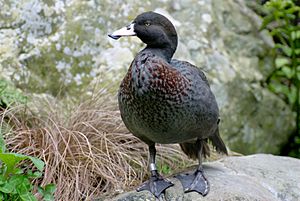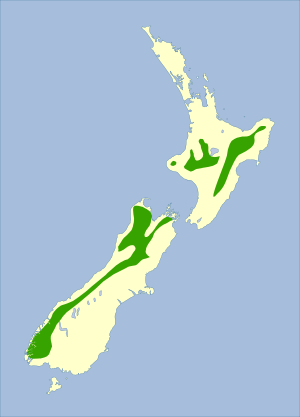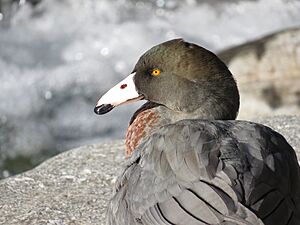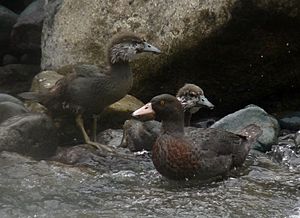Blue duck facts for kids
Quick facts for kids Blue duck |
|
|---|---|
 |
|
| Blue duck at Staglands, Akatarawa Valley | |
| Conservation status | |
| Scientific classification | |
| Genus: |
Hymenolaimus
|
| Species: |
malacorhynchos
|
 |
|
| Synonyms | |
|
Hymenolaimus malacorhynchus ssp. malacorhynchus (Gmelin, 1789) – Collar et al. (1994) |
|
The blue duck, also known as whio (pronounced "fee-o"), is a special type of duck found only in New Zealand. It's part of the duck, goose, and swan family, called Anatidae. This duck is so unique, it's the only one in its entire group, called Hymenolaimus. Scientists are still figuring out its exact family tree, but it seems to be related to "dabbling ducks."
You can even see the whio on the back of the New Zealand $10 banknote!
What is a Whio?
Why is it called Whio?
The blue duck is commonly known by its Māori name, Whio. This name sounds like the male duck's call. It's an example of an onomatopoeic word, meaning it imitates the sound it describes. Some people also call it the Mountain Duck or Blue Mountain Duck.
What does a Blue Duck look like?
Blue ducks are about 53 to 54 centimeters (21 to 21.3 inches) long. Their weight depends on whether they are male or female. Females are smaller, weighing between 680 and 870 grams (1.5 to 1.9 pounds). Males are heavier, weighing 820 to 1077 grams (1.8 to 2.4 pounds).
Their feathers are a dark slate-grey color. Their head has a shiny greenish look, and their chest has chestnut-colored spots. The outer feathers on their wings have white tips. Both male and female ducks look very similar, though females have slightly less chestnut on their chests.
A blue duck's bill is pinkish-white. It has soft, fleshy flaps of skin on the sides of its tip. When a blue duck chick hatches, its beak is green for only about eight hours. After that, it changes to its final pinkish-white color.
What sounds do they make?
The male blue duck makes a high-pitched whistle. The female's call is a rough growl or low, grating sound.
Where do Blue Ducks Live?
Their Home in New Zealand
The blue duck is a native bird that lives only in New Zealand. It builds its nests in hollow logs, small caves, and other safe, sheltered places. This duck is quite rare. It prefers to live in fast-flowing mountain rivers.
Blue ducks are very strong swimmers, even in powerful currents. However, they don't like to fly much. They can be hard to find, but once you spot one, they aren't usually very shy.
What do Blue Ducks eat?
Blue ducks mostly eat small water creatures, called aquatic invertebrates. Most of their diet consists of caddisfly larvae. Sometimes, they might also eat berries and fruits from shrubs.
How do Blue Ducks raise their young?
Blue ducks usually nest between August and October. The female lays about 4 to 9 creamy white eggs. She sits on the eggs for 35 days to keep them warm. The chicks are ready to fly when they are about 70 days old.
The female duck takes care of the nesting and egg incubation. Meanwhile, the male duck stands guard to protect the nest. Nests are shallow, lined with twigs, grass, and soft down feathers. They are often found in caves, under plants near rivers, or in piles of logs. This means their nests can be easily washed away by spring floods. Because of this, and other reasons, their breeding success can change a lot from year to year.
Protecting the Blue Duck
Why are Blue Ducks endangered?
The blue duck is classified as an Endangered animal by the IUCN. This is because their population is very small and spread out, and it's getting even smaller. In New Zealand, they are listed as Nationally Endangered. A count in 2010 estimated there were only about 2,500 to 3,000 individual blue ducks left, with a maximum of 1,200 pairs.
Blue ducks face several threats. They are hunted by introduced mammals like stoats. They also have to compete for their food (small water creatures) with introduced trout. Building dams on mountain rivers for electricity also harms their habitat.
Female whio are especially in danger from stoats when they are nesting. In some areas, the number of males is now 70 percent higher than females. One study showed that clutches of eggs were destroyed by stoats in about nine days. Even one group of chicks that hatched was killed the very next day.
What is being done to help?
Scientists and volunteers are working hard to protect the blue duck. In 2009, the New Zealand Department of Conservation started a ten-year plan. This plan aims to protect the ducks at eight special sites by controlling predators. Then, they hope to help the duck populations grow again across their original homes.
In 2011, the New Zealand Department of Conservation and Genesis Energy began the Whio Forever Project. This five-year program helps manage the whio population. It will help create more safe breeding sites for blue ducks across New Zealand. It also boosts efforts to control pests that harm the ducks.
Blue Ducks in Captivity
Blue ducks from the North Island of New Zealand are kept and bred in captivity on both the North and South Islands. However, their offspring are returned to their original island. South Island whio are only kept and bred in captivity on the South Island. All captive ducks are cared for by approved wildlife facilities. This is part of the national recovery plan.
A program called WHIONE is part of this plan. It uses specially trained dogs to find whio nests. The eggs are then carefully removed, and the ducklings are hatched and raised in captivity. Later, they are prepared to be released back into the wild.
See also
 In Spanish: Pato azul para niños
In Spanish: Pato azul para niños




